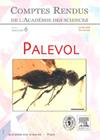New data on Barbatodon oardaensis Codrea, Solomon, Venczel & Smith, 2014, the smallest Late Cretaceous multituberculate mammal from Europe
IF 1.3
4区 地球科学
Q3 PALEONTOLOGY
引用次数: 0
Abstract
Surprisingly, after the Early Cretaceous taxonomic diversity recorded in Europe, which probably is largely an artifact of inadequate taxonomy and inflation of taxa, multituberculate mammals became extremely scarce in the Late Cretaceous in this continent, being reported exclusively from the uppermost Cretaceous continental deposits of the so-called “Hațeg Island” in Transylvania, Romania. Such mammals have been documented from the Hațeg and Rusca Montană sedimentary basins, as well as from the southwestern area of the Transylvanian Basin. All these records belong to the endemic family Kogaionidae. The present paper reports additional data related to the smallest Cretaceous kogaionid, Barbatodon oardaensis Codrea, Solomon, Venczel & Smith, 2014 based on a series of new isolated teeth recovered mainly from the type locality, Oarda de Jos (Oarda A). Furthermore, the fossil localities Oarda B and Vălioara are other new occurrences for the species. Based on this new material, the intraspecific variability of B. oardaensis is confirmed and its presence is attested in the three basins. Details related to the diversity of the “Hațeg Island” kogaionids are also provided.关于Barbatodon oardaensis Codrea的新数据,Solomon, Venczel & Smith, 2014,欧洲最小的晚白垩纪多瘤哺乳动物
令人惊讶的是,在欧洲记录的早白垩纪分类多样性之后,多瘤哺乳动物在这个大陆的晚白垩纪变得极其稀少,只报道了在罗马尼亚特兰西瓦尼亚所谓的“Hațeg岛”的白垩纪大陆沉积物。这些哺乳动物在Hațeg和Rusca montani沉积盆地以及特兰西瓦尼亚盆地的西南地区都有记录。这些记录均属于特有科科。本文基于主要在Oarda de Jos (Oarda a)类型地点发现的一系列新的分离牙齿,报道了2014年最小的白垩纪kogaionid, Barbatodon oardaensis Codrea, Solomon, Venczel & Smith。此外,化石地点Oarda B和vlioara是该物种的其他新发现。在此基础上,确认了B. oardaensis的种内变异性,并证实了其在三个盆地的存在。还提供了与“Hațeg岛”科格昂科尼的多样性有关的细节。
本文章由计算机程序翻译,如有差异,请以英文原文为准。
求助全文
约1分钟内获得全文
求助全文
来源期刊

Comptes Rendus Palevol
地学-古生物学
CiteScore
2.10
自引率
0.00%
发文量
39
审稿时长
17.6 weeks
期刊介绍:
Comptes Rendus Palevol is a fully electronic and peer-reviewed journal, with a continuous publication stream, devoted to palaeontology, prehistory and evolutionary sciences. It publishes original research results, in French or English, in the following domains: systematic and human palaeontology, prehistory, evolutionary biology and macroevolution, and history of sciences. Thematic issues may also be published under the responsibility of a guest editor. All articles published in Comptes Rendus Palevol are compliant with the different nomenclatural codes. A copyright assignment will be signed by the authors before publication.
 求助内容:
求助内容: 应助结果提醒方式:
应助结果提醒方式:


